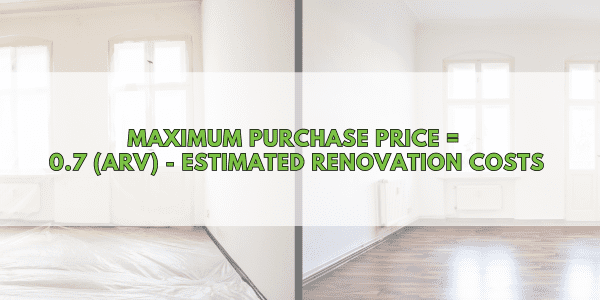In the world of real estate investing, fix and flip projects have gained immense popularity due to their potential for quick and substantial returns. These short-term endeavors involve purchasing undervalued properties, renovating them to enhance their value, and then reselling them at a profit. While the allure of significant gains is undeniable, it’s crucial to approach fix-and-flip investing with a strategic mindset and a deep understanding of the underlying principles. This is where the 70% rules comes into play.

The 70% rule is a guideline that helps fix-and-flip investors determine the maximum purchase price they should pay for a property to ensure profitability. It states that the maximum purchase price should not exceed 70% of the property’s after-repair value (ARV) minus the estimated renovation costs.
Understanding the Rationale Behind the Rule
The 70% rule serves as a safeguard against overpaying for a property, thereby reducing the risk of financial losses. By adhering to this rule, investors leave a buffer of 30% to cover various expenses, including:
- Closing costs: The fees associated with purchasing a property, such as title insurance and lender fees.
- Financing costs: The interest paid on the fix-and-flip loan.
- Unexpected expenses: Unforeseen repairs or construction delays that may arise during the renovation process.
- Holding costs: The ongoing expenses incurred while the property remains unsold, such as property taxes, utilities, and insurance.
- Profit margin: The desired profit investors aim to achieve from the project.
Applying the Rule in Practice: A Step-by-Step Guide
- Determine the ARV: Accurately assess the property’s potential resale value once renovations are complete. This requires thorough market research and consultation with experienced real estate professionals.
- Estimate renovation costs: Obtain detailed estimates from reputable contractors to determine the overall cost of renovations. Factor in both hard costs (materials and labor) and soft costs (permits, design fees, and contingencies).
- Calculate the maximum purchase price: Apply the 70% rule formula:

- Compare to market prices: Research comparable properties in the area to ensure the calculated purchase price aligns with market trends.
- Make informed decisions: Based on the analysis, decide whether to proceed with the investment or see out alternative opportunities.
The 70% Rule: A Valuable Tool for Fix-and-Flip Success
The 70% rule serves as a valuable tool for fix-and-flip investors, providing a framework for making informed decisions and reducing the risk of overpaying for properties. However, it’s important to note that the rule is a guideline, not a rigid formula. Experienced investors may adjust the percentage based on their level of expertise, the specific property, and local market conditions.
Additional Tips for Fix and Flip Success
- Conduct thorough market research: Understand local demand, appreciation trends, and potential challenges before investing.
- Partner with experienced professionals: Engage experienced real estate agents, contractors, and financial advisors for guidance.
- Manage finances effectively: Create a detailed budget, track expenses diligently, and maintain adequate contingency funds.
- Prioritize quality renovations: Focus on renovations that enhance the property’s value and appeal to the target market.
- Market the property effectively: Utilize effective marketing strategies to reach potential buyers and achieve a quick sale.
Remember, fix-and-flip investing involves inherent risks, and it’s crucial to approach each project with sound judgement and risk mitigation strategies. By understanding the 70% rule, its underlying principles, and additional strategies, you can navigate the fix-and-flip landscape with greater confidence and increase your chances of achieving success in this dynamic investment arena.

Stay in the Loop
Subscribe to our newsletter
